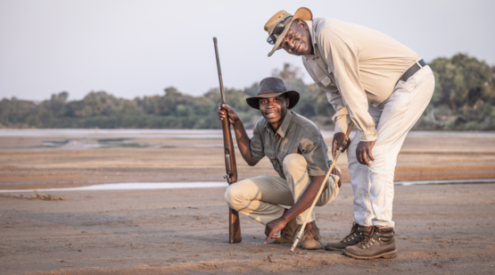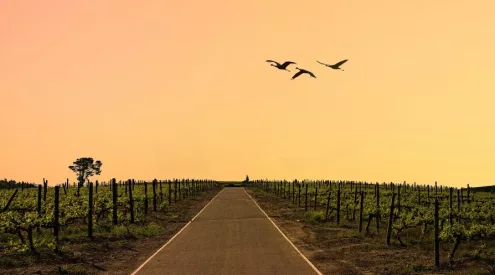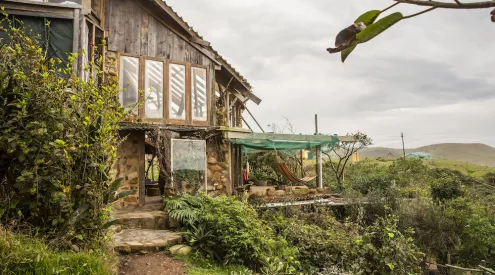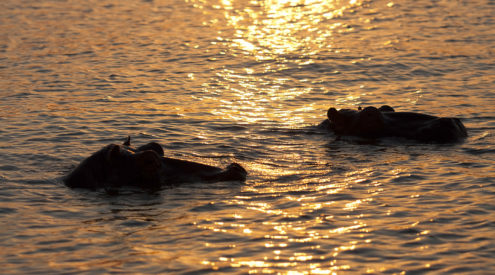The heavy summer rains brought floods to Botswana, yet avid campers persevered and the reward was great. Colourful plumage filled the trees and beaks picked triumphantly on the season’s medley of insects at the water’s edge. These are the birds of Botswana…

An egret taking off from its hippo perch, whom it relieves of parasites while equally benefiting from the nourishment these mites provide. Photo by Rory Bruins.
A very wet season in Botswana has presented some challenges to campers and travellers, who simultaneously appreciate the gift of rain given by Mother Nature, and curse the tent leaks and flooded roads. Amid the chaos, piscivorous birds rejoice in the fish-filled rivers, wading birds flock to the brimming lakes and a colourful array of feathered creatures take to the trees to feast on the harvest of the summer season.
Rory Bruins, camera in hand, set out in his 4X4 over December in the wettest of wet and covered most of Botswana’s glorious national parks and reserves. In the Moremi and Khwai Game Reserves, in the region of the great Okavango Delta, Rory photographed a number of busy birds as they scoured the ground for grubs and plucked insects from the air.

The knob-billed or Comb duck is defined by the unusual fleshy growth on the male’s beak. This odd looking addition enlarges during breeding season, clearly intended to attract a female mate. Photo by Rory Bruins.
We know him as Zazu, Mufasa’s loyal bird-PA in the Lion King, but off-screen, the red-billed hornbill serves another member of the animal kingdom. These commonly seen birds have a mutually beneficial relationship with dwarf mongooses, offering the luxury of a warning call in return for easy prey. The mongooses often await the arrival of the hornbills before setting out foraging in the morning, and similarly, if the hornbills arrive early, they send a noisy wakeup call into mongoose burrows to get the foraging started. On the lookout for predators, hornbills keep the mongooses safe, while swooping to snatch up any flyaway insects disturbed by the mongooses.
Hornbills have a complex breeding behaviour that begins with pair bonding and visual displays, and builds trust between the male and the female for the duration of the season. Prior to laying eggs, the female hornbill gets sealed into a pre-existing hole in the trunk of a tree using mud, food remains and droppings, leaving only a narrow opening big enough for her to receive food from her mate. The female sheds all her feathers, which then line the nest and cradle her eggs safely. Once the chicks are of age, the female has regrown all her feathers and breaks her way out of the nest, not forgetting to seal it up again with her chicks inside. Both male and female hornbills will take on the feeding duty until the chicks are old enough to fly. After 3 weeks as a family, the young’uns fledge and seek a mate of their own.

Red-billed hornbills emit an unmistakable sound that has become known as the Dawn Chorus. Photo by Rory Bruins.
Aptly named in French (Marabou means ‘ugly, misshapen, old man’), the Marabou stork is a terrifically unattractive bird that joins the hyena, wildebeest, warthog, and vulture in Africa’s ‘Ugly Five’. Its hunched form can be seen awkwardly balancing atop trees when it is not feeding itself by scavenging after vultures and other messy carnivores. Marabou storks are meat-eaters, but their beaks are not equipped for tearing off bites of their own, and instead they grab the bite-size scraps left over from others.

A Marabou stork guzzling what appears to be a legless skink, demonstrating that they do hunt small enough prey themselves. Photo by Rory Bruins.

Little bee-eaters unsurprisingly eat bees, as well as wasps and other flying insects . Before consuming, these birds strike their prey against a hard surface, thereby removing their stings and venom. Photo by Rory Bruins
One of the much more beautiful species starring in Botswana’s avian parade is the Lilac-breasted roller. Hungry for meat, this colourful bird perches high up on bare branches either alone or in close pairs, keeping an eye out for insects, scorpions, snails, lizards, even small birds on which to prey. A breeding pair of lilac-breasted rollers nest in a pre-existing tree hole where a clutch of up to 4 eggs is incubated and protected fiercely by both male and female. A roller’s claim to fame, and indeed its namesake, is its dramatic show of soaring into the air and plummeting from a height in a sort of somersault motion while exhibiting a less than songful call. This beautiful bird certainly does not have a voice to match its vibrant plumage.

Lilac-breasted roller perched characteristically on a bare branch from where it vigilantly monitors the ground for live prey. Photo by Rory Bruins.
Out of the 9 species of kingfisher occurring in Botswana, this small black and white bird is the only one demonstrating hovering behaviour. Instead of quietly awaiting the moment to plunge from an extended branch, the Pied kingfisher flies above the water and hovers (not quite as expertly as a hummingbird) above its intended prey before nose-diving through the surface and retrieving its fishy prize. Its eyes naturally correct refraction of the water making sure the bird can judge the exact position of its prey, and its transparent eyelids are designed to cover the eyes yet maintain vision as the bird enters the water. Unlike most other kingfishers, Pied kingfishers are co-operative breeders, meaning that the breeding pairs receive assistance in caring for their young from their older offspring and other non-breeding adults.

Pied kingfisher caught in action as it emerges from the water with its prey. Photo by Rory Bruins.
Woodpeckers not only drum furiously onto the trunks of trees to access the delicious mites that dwell within, they also rap their beaks quickly against the bark as a means of communication. The resounding noise can be heard afar and is the unmistakable call of these pretty birds. They have unique adaptations from their feet to their beaks that suit the birds to their heavy duty jobs. Woodpeckers’ brains are cushioned against the pressure of drumming into wood, and their exceptionally long tongues begin behind their eye sockets, providing a sort of shock absorber preventing the bird from falling unconscious. They have 2 toes facing backwards and 2 facing forwards, so that they can comfortably cling to the trees in a vertical position. Their tail feathers are sturdier than usual and press onto the trunk of the tree, providing support in the way that a tripod does.

Bennett’s Woodpecker extending its long tongue in search of tasty morsels boring into the bark. Photo by Rory Bruins.

The yellow-billed stork is often seen in this position with its long beak slightly ajar and submerged in water. This stork uses one of its feet to disturb the ground and flush out its prey. Photo by Rory Bruins.



















